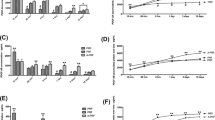Abstract
Positively charged peptides [(Arg)-Cys] were sucessfully linked to tissue-specific plasminogen activator (tPA) using cross-linking agent N-succinimidyl 3-(2-pyridyldithio) propionate. Specific amidolytic activity of this tPA/(Arg)-Cys (termed modified tPA, mtPA) was 3900 IU/μg as compared to 5800 IU/μg of the parent tPA. Both activation of plasminogen with mtPA (Km=2.7 mM−1) and tPA (Km=1.1 mM−1) in a purified system followed Michaelis-Menten kinetics. In addition, (Arg)-Cys modification did not result in significant changes in the fibrin-binding ability of tPA, and mtPA still retained a response to fibrinogen similar to that of the parent tPA. Compared with tPA, mtPA showed much stronger heparin affinity, and the heparin/mtPA complex was stable in human plasma. The activity of mtPA in such a complex was inhibited by heparin, and, unlike tPA, the heparin/mtPA complex did not cause statistically meaningful depletion of plasminogen, fibrinogen, and α2-antiplasmin in plasma. Using the chromogenic and the in vitro clot lysis assay, it was demonstrated that the heparin-induced inhibition of the mtPA activity was easily reversed following the addition of an adequate amount of protamine. To enhance the clot-targeting efficiency of the heparin/mtPA complex further, anti-fibrin immunoglobulin (IgG) was conjugated to heparin via an end-point attachment of heparin to the sugar moieties in the Fc region of the IgG. Results show that the activity of mtPA could also be blocked by the heparin/anti-fibrin IgG conjugate. These findings suggest the applicability of the heparin/protamine delivery system to abort the potential bleeding risks associated with clinical use of tPA.
Similar content being viewed by others
References
Cooney DA, Rosenbluth RJ. Enzymes as therapeutic agents. Adv Pharmacol Chemother, 1975; 12: 185–289.
Veronese FM, Morpurgo M. Bioconjugation in pharmaceutical chemistry. Farmaco, 1999; 54: 497–516.
Mumtaz S, Bachhawat BK. Conjugation of proteins and enzymes with hydrophilic polymers and their applications. Indian J Biochem Biophys, 1991; 28: 346–51.
Chang TM. Artificial cells, encapsulation, and immobilization. Ann NY Acad Sci, 1999; 875: 71–83.
Stricker RB, Wong D, Shiu DT, Reyes PT, Shuman MA. Activation of plasminogen by tissue plasminogen activator on normal and thrombasthenic platelets: effects on surface proteins and platelet aggregation. Blood, 1986; 68; 275–280.
Marder VJ, Shulman NR. High molecular weight derivatives of human fibrinogen produced by plasmin II. Mechanism of their anticoagulant activity. J Biol Chem, 1969; 244: 2120–2124.
Collen D, Stump DC, Gold HK. Thrombolytic therapy Annu Rev Med, 1988: 39: 405–423.
Collen D, Lijnen HR. On the future of thrombolytic therapy for acute myocardial infarction. Am J Cardiol. 1993; 72: 46G-50G.
Collen D. Towards improved thrombolytic therapy. Lancet. 1993; 342: 34–36.
Lijmen HR, Collen D. Strategies for the improvement of thrombolytic agents. Thromb Haemost, 1991; 66: 88–110.
Majerus PW, Bronze Jr GJ, Miletich JP, Tollefsen DM Anticoagulant, thrombolytics, and antiplatelet drugs In: Gilman’s The Pharmacological Basis of Therapentics 9th ed. New York: McGraw-Hill, 1995; 1341–1359.
Anderson HV, Willerson JT. Thrombolysis in acute myocardial infarction [see comments]. N Engl J Med. 1993; 329: 703–709.
Huber K, Runge MS, Bode C, Gulba D. Thrombolytic therapy in acute myocardial infarction update 1996. Ann Hematol. 1996; 73: S29–38.
Byun Y, Yang VC. Delivery system for targeted thrombolysis without the risk of hemorrhage. ASAIO J. 1998; 44: M638-M641.
Turpie AGG. Thrombolytic therapy in venous thromboembolism. In: Sobel BE, Collen D, Grossbard EB. eds. Tissue Plasminogen Activator in Thrombolytic Therapy. New York: Marcel Dekker. 1987; 131–146.
Bernstein H, Yang VC, Langer R. An investigation of heparinase immobilization. Appl Biochem Biotechnol. 1987; 16: 129–143.
Lanevschi A, Kramer JW, Greene SA, Meyers KM. Evaluation of chromogenic substrate assays for fibrinolytic analytes in dogs. Am J Vet Res. 1996; 57: 1124–1130.
Yun JH, Ma SC, Fu B, Yang VC, Meyerhoff ME. Direct potentiometric membrane-electrode measurements of heparin-binding to macromolecule. Electroanalysis. 1993; 5: 719–724.
Byun Y, Singh VK, Yang VC. Low molecular weight protamine: a potential non-toxic heparin antagonist. Thromb Res. 1999; 94: 53–61.
Ramamurthy N, Baliga N, Wakefield TW, Andrews PC. Yang VC, Meyerhoff ME. Determination of low molecular weight heparins and their binding to protamine and a protamine analogue using polyion-sensitive membrane electrodes. Anal Biochem, 1999; 266: 116–124.
Collen D, Verstraete M. Systemic thrombolytic therapy of acute myocardial infarction? Circul. 1983; 68: 462–465.
Fox KA, Bergmann SR, Sobel BE. Coronary thrombolysis: pharmacological considerations with emphasis on tissue-type plasminogen activator (t-PA). Biochem Pharmacol. 1984; 33. 1831–1838.
Owen J, Friedman KD, Grossman BA, Wilkins C, Berke AD, Powers ER. Quantitation of fragment X formation during thrombolytic therapy with streptokinase or tissue plasminogen activator. J Clin Invest. 1987; 79: 1642–1647.
Rao AK, Pratt C, Berke A, Jaffe A, Ockene I, Schreiber TL, et al. Thrombolysis in myocardial infarction (TIMI) trial phase 1: hemorrhagic manifestation and changes in plasma fibrinogen and the fibrinolytic system in patients treated with recombinant tissue plasminogen activator and streptokinase. J Am Coll Cardiol. 1988; 11: 1–11.
Verstraete M, Miller GA, Bounameaux H, Charbonnier B, Colle JP, Lecorf G, et al. Intravenous and intrapulmonary recombinant tissue-type plasminogen activator in the treatment of acute massive pulmonary embolism. Circulation, 1988; 77: 353–360.
Levine MN, Hirsh J, Weitz J, Cruickshank M, Neemeh J, Turpie AGG, et al. A randomized trial of a single bolus dosage regimen of recombinant tissue plasminogen activator in patients with acute pulmonary embolism. Chest, 1990; 98: 1473–1479.
Author information
Authors and Affiliations
Corresponding author
Additional information
Published March 21, 2000
Rights and permissions
About this article
Cite this article
Liang, J.F., Li, Y.T., Connell, M.E. et al. Synthesis and characterization of positively charged tPA as a prodrug using a heparin/protamine-based drug-delivery system. AAPS PharmSci 2, 7 (2000). https://doi.org/10.1208/ps020107
Received:
Accepted:
Published:
DOI: https://doi.org/10.1208/ps020107




